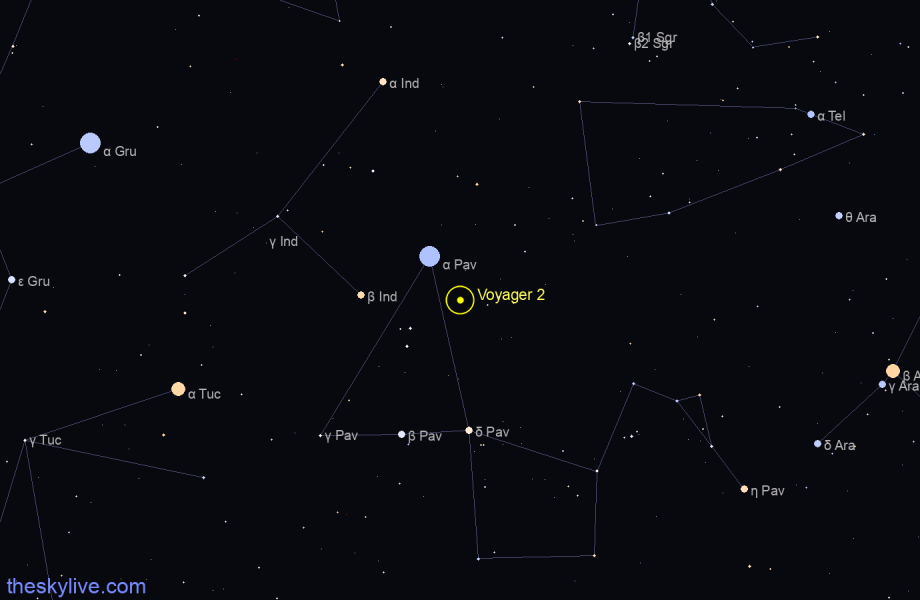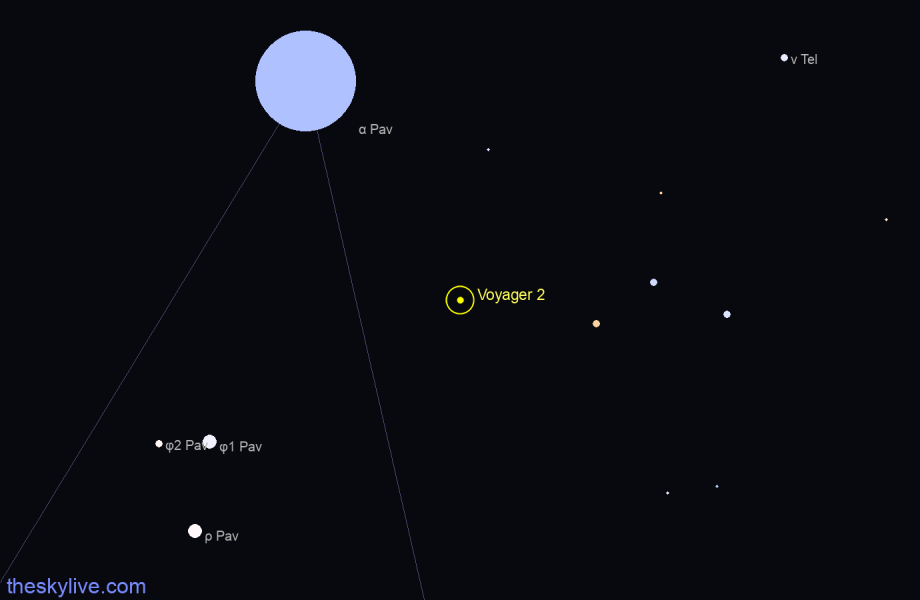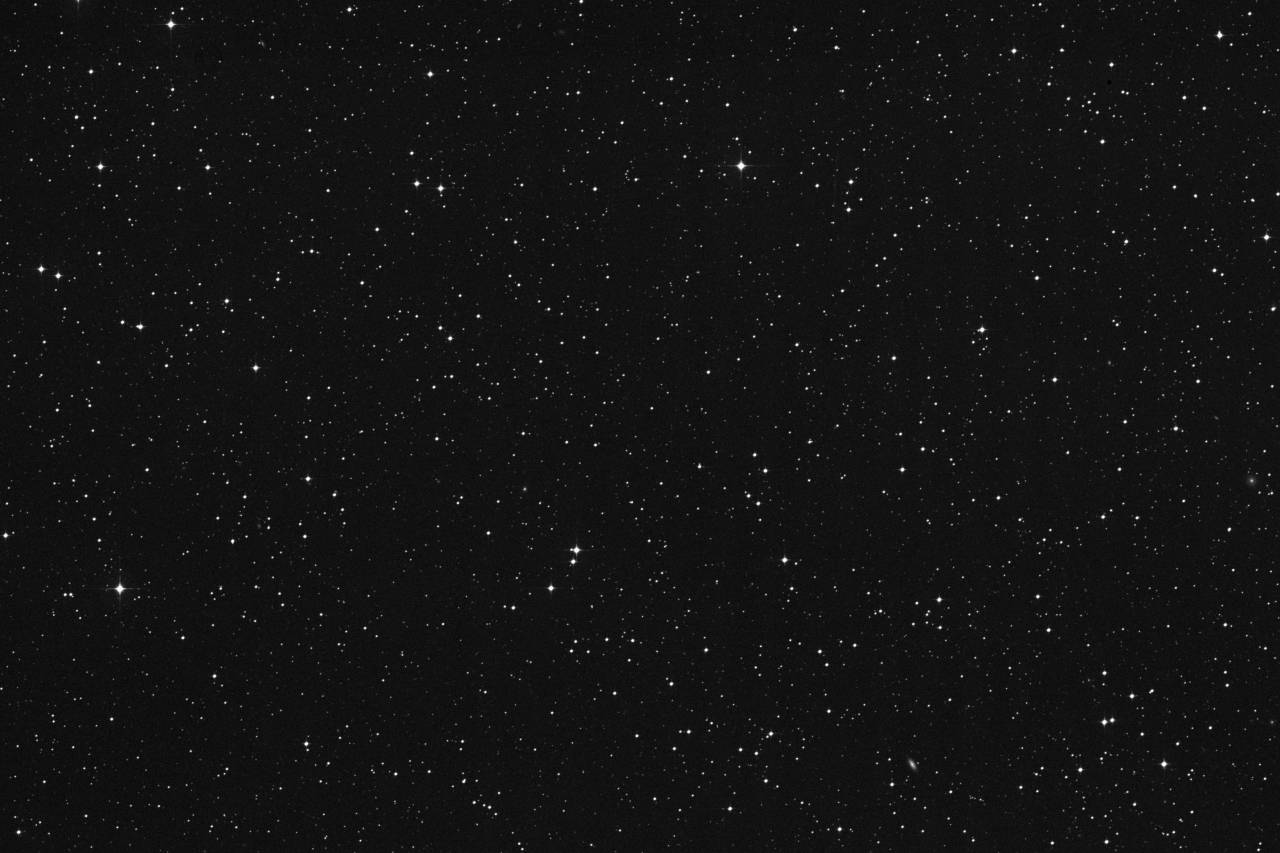Voyager 2
Voyager 2 is an unmanned space probe launched by NASA on August 20, 1977, just a few weeks before its sister craft Voyager 1. Its mission was to study the outer planets of our solar system, including Jupiter, Saturn, Uranus, and Neptune. It was the first and only spacecraft to visit all four planets, and its observations revolutionized our understanding of these distant worlds. After completing its primary mission, Voyager 2 continued on its journey into interstellar space, where it is still sending back data on the interstellar medium and the heliosphere. Voyager 2 is currently the second most distant human-made object from Earth, after its sister craft Voyager 1, and continues to be in communication with NASA's Deep Space Network.
Voyager 2 is currently in the constellation of Pavo, at a distance of 20,368,450,985 kilometers from Earth.
View interactive star map
Today's rise, transit and set times of Voyager 2 from Greenwich, United Kingdom (all times relative to the local timezone Europe/London):
- Voyager 2 is below the horizon from Greenwich, United Kingdom .
- Go to interactive sky chart
If you need to access this information frequently for your observations, you can create a simple customized Quick Access page, so that you can easily bookmark it in your browser favorites or add a shortcut to your mobile phones' home screen.
Higher precision deep sky finder chart, 60 arcmin wide, showing where Voyager 2 is right now. Click on the image to see a more detailed fullscreen tracker view.
Also check out Where is Voyager 2?, a page that provides all the information needed to find Voyager 2 in the sky and additional links to sky charts.
Voyager 2 Distance from Earth
The distance of Voyager 2 from Earth is currently 20,368,450,985 kilometers, equivalent to 136.154685 Astronomical Units. Light takes 18 hours, 52 minutes and 21.8392 seconds to travel from Voyager 2 and arrive to us.
The following chart shows the distance of Voyager 2 from Earth as a function of time. In the chart the distance data is measured in Astronomical Units and sampled with an interval of 1 day.
The value of the reported distance might be somewhat inaccurate around the times of closest approach for objects passing extremely close to Earth. The value of the distance of Voyager 2 from Earth is also available as a real time updated value in the Live Position and Data Tracker.
Closest Approach of Voyager 2 to Earth
Between 1 January 2013 and 30 December 2099, the closest approach of Voyager 2 to Earth happens on Sun Jun 2 2013 at a distance of 101.162452 Astronomical Units, or 15,133,687,450 kilometers:
NOTE: values for the closest approach are computed with a sampling interval of 1 day.
Visualization of Voyager 2 Orbit
This 3d orbit diagram is a feature of our 3D Solar System Simulator and shows the orbit of Voyager 2 with respect of the Sun and the orbits of the major planets. The position of Voyager 2 and the planets along their orbits in this diagram accurately represents the current configuration of the objects in the Solar System. This is an experimental feature and it requires a WebGL enabled browser. Please provide us feedback!
Voyager 2 15 Days Ephemeris
The following table lists the ephemerides of Voyager 2 computed for the past and next 7 days, with a 24 hours interval. Click on each row of the table to locate Voyager 2 in our Online Planetarium at the chosen date.
| Date | Right AscensionR.A. | DeclinationDec. | MagnitudeMag | Constellation |
|---|---|---|---|---|
| 2024 Apr 19 | 20h 13m 36s | -59° 01’ 05” | N.A. | Pavo |
| 2024 Apr 20 | 20h 13m 36s | -59° 01’ 23” | N.A. | Pavo |
| 2024 Apr 21 | 20h 13m 36s | -59° 01’ 41” | N.A. | Pavo |
| 2024 Apr 22 | 20h 13m 36s | -59° 01’ 59” | N.A. | Pavo |
| 2024 Apr 23 | 20h 13m 36s | -59° 02’ 18” | N.A. | Pavo |
| 2024 Apr 24 | 20h 13m 36s | -59° 02’ 36” | N.A. | Pavo |
| 2024 Apr 25 | 20h 13m 36s | -59° 02’ 56” | N.A. | Pavo |
| 2024 Apr 26 | 20h 13m 36s | -59° 03’ 15” | N.A. | Pavo |
| 2024 Apr 27 | 20h 13m 36s | -59° 03’ 33” | N.A. | Pavo |
| 2024 Apr 28 | 20h 13m 36s | -59° 03’ 51” | N.A. | Pavo |
| 2024 Apr 29 | 20h 13m 36s | -59° 04’ 10” | N.A. | Pavo |
| 2024 Apr 30 | 20h 13m 36s | -59° 04’ 30” | N.A. | Pavo |
| 2024 May 01 | 20h 13m 35s | -59° 04’ 49” | N.A. | Pavo |
| 2024 May 02 | 20h 13m 35s | -59° 05’ 07” | N.A. | Pavo |





